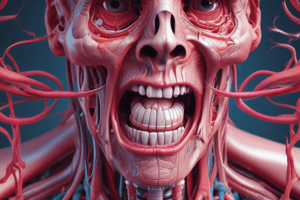Podcast
Questions and Answers
What type of epithelial tissues cover the oral cavity?
What type of epithelial tissues cover the oral cavity?
- Squamous epithelial tissues (correct)
- Cuboidal epithelial tissues
- Transitional epithelial tissues
- Columnar epithelial tissues
Which part of the oral cavity has non-keratinised epithelium?
Which part of the oral cavity has non-keratinised epithelium?
- Cheek (correct)
- Mucosa
- Attached gingiva
- Hard palate
Where is the submucosa not present in the oral cavity?
Where is the submucosa not present in the oral cavity?
- Soft palate
- Hard palate (correct)
- Tongue
- Uvula
What structure in the oral cavity serves as a landmark for an inferior alveolar nerve block?
What structure in the oral cavity serves as a landmark for an inferior alveolar nerve block?
Which area in the oral cavity forms the vestibule?
Which area in the oral cavity forms the vestibule?
What is the function of keratinisation in the oral cavity?
What is the function of keratinisation in the oral cavity?
What is the function of cementum?
What is the function of cementum?
Which cells are responsible for the formation and maintenance of cementum?
Which cells are responsible for the formation and maintenance of cementum?
What is the relationship between cementum and enamel at the cemento-enamel junction (CEJ)?
What is the relationship between cementum and enamel at the cemento-enamel junction (CEJ)?
What is the characteristic of the alveolar bone that lines the tooth socket?
What is the characteristic of the alveolar bone that lines the tooth socket?
Which layer of the oral mucosa is keratinized?
Which layer of the oral mucosa is keratinized?
What is the difference between ortho-keratinized and para-keratinized tissues?
What is the difference between ortho-keratinized and para-keratinized tissues?
Flashcards are hidden until you start studying
Study Notes
Tooth Structure
- Enamel is derived from the enamel organ
- Dentine is derived from the dental papilla
- Cementum is derived from the dental follicle
- Periodontal ligament is derived from the dental follicle
- Alveolar bone is derived from the dental follicle
- Gomphosis is the type of joint that holds the tooth in place
Cementum
- Derived from dental follicle
- Mineralized, calcified tissue
- Composed of 50-55% organic fibrous (proteins) and 40-50% inorganic (minerals) components
- Acellular (no cells) in the coronal area and cellular (has cells) in the apical area
- Provides attachment to periodontal fibers
- Covers and protects the root dentin, sealing the opening of dentinal tubules
- Cells in cementum: cementocytes (inside), cementoblasts (outside, produces cementum), and cementoclasts (clears cementum)
Cementum Thickness
- Thickest at the apex of the tooth or inter-radicular areas (molars)
- Thinnest in the coronal area
CEJ (Cemento-Enamel Junction)
- Can be seen in three forms: cementum overlaps enamel (60% of people), cementum just meets enamel (30% of people), and small gap between cementum and enamel (10% of people, sensitive dentine)
Ageing of Cementum
- Continuous deposition of cementum occurs
- Cementum resorption and root dentin resorption can occur
Periodontium
- Consists of gingiva, cementum, periodontal ligament, and alveolar bone
- Supports the tooth
Alveolar Bone
- Outer cortical plates (hard bone)
- Central spongiosa (spongy bone, cancellous, or trabecular bone)
- Lining the alveolus is bundle bone or lamina dura or alveolar bone proper
Oral Mucosa
- Overlying oral epithelium
- Underlying connective tissue (lamina propria and submucosa)
- Structure similar to skin, with epidermis and dermis layers
Epithelium
- Stratum corneum (keratinized cell)
- Stratum granulosum (granular cell)
- Stratum spinosum (prickle cell)
- Stratum basale (basal cell)
- Ortho-keratinized (has keratin, no nucleus), para-keratinized (has keratin, has nucleus), and non-keratinized (no keratin, has nucleus)
Oral Cavity
- Soft tissues: squamous epithelial tissues (non-keratinized)
- Keratinized areas: hard palate and attached gingiva
- Non-keratinized areas: tongue, cheek, and soft palate
Mucosa and Submucosa
- Mucosa consists of epithelium and supporting loose connective tissue (lamina propria)
- Submucosa consists of deeper connective tissue that supports the mucosa
- Two areas without submucosa: hard palate and attached gingiva
Studying That Suits You
Use AI to generate personalized quizzes and flashcards to suit your learning preferences.




